Pandemic (H1N1) 2009 influenza in NSW: an overview of the public health response
Paula J. Spokes A C , Michelle A. Cretikos A and John G. Ward AA Communicable Diseases Branch, NSW Department of Health
B AIDS/Infectious Diseases Branch, NSW Department of Health
C Corresponding author. Email: pspok@doh.health.nsw.gov.au
NSW Public Health Bulletin 21(2) 4-9 https://doi.org/10.1071/NB09035
Published: 8 April 2010
Abstract
In April 2009, a new influenza A virus, pandemic (H1N1) 2009 influenza, was identified in Mexico and the United States of America. The NSW response was co-ordinated by the Public Health Emergency Operations Centre through an incident control structure that included planning, operations and logistics teams with designated roles and responsibilities for the public health response. The emphasis of public health action changed as the pandemic moved through three response phases: DELAY, CONTAIN and PROTECT. This article describes the NSW public health response to the 2009 influenza pandemic from the perspective of the NSW Department of Health.
On 24 April 2009, the World Health Organization (WHO) reported that a novel swine influenza A virus (H1N1) had been identified in humans in the United States of America (USA).1 At the same time, hundreds of cases of pneumonia and other serious respiratory illness causing intensive care admission in healthy young adults were reported from Mexico.1 On 26 April, WHO declared the situation to be a public health emergency of international concern.2
A novel influenza virus with evidence of human-to-human transmission is a public health concern because the community is likely to be completely susceptible to the new virus. Evidence of serious respiratory illness and reports of deaths further heightened the level of concern, and a public health emergency response was initiated in New South Wales (NSW) on 26 April 2009.
Public health response phases
Significant public health action was required to help control the spread of pandemic (H1N1) 2009 influenza in the community. The public health response used the framework described in the Australian Health Management Plan for Pandemic Influenza 2008.3 Management of the pandemic moved through three phases: DELAY (of the virus into Australia); CONTAIN (early identification of cases and contacts to contain transmission in the community); and PROTECT (identification of high-risk groups to protect those most at risk of severe illness) (Table 1).
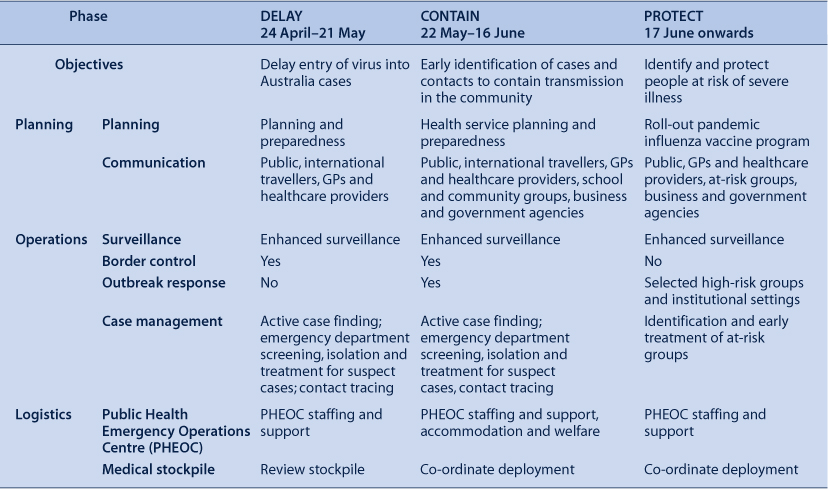
|
The public health response was co-ordinated through an incident management system that included an incident controller and separation of activities into three areas: planning, operations and logistics (Figure 1).4
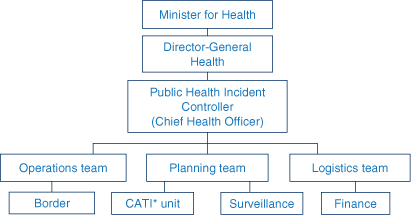
|
DELAY and CONTAIN phases
The first case of pandemic (H1N1) 2009 influenza in Australia was reported from Queensland on 8 May.5 The first NSW case was not identified until 20 May in a traveller returning from the USA.6 This case was considered non-infectious. Australia moved to the next response phase, CONTAIN, on 22 May in response to the identification of suspected community transmission in Victoria.7,8
Planning
Planning for an influenza pandemic had been in progress in NSW since at least 2005. The NSW Interim Influenza Pandemic Action Plan 20059 and the Australian Health Management Plan for Pandemic Influenza 20083 formed the basis of the public health response to the pandemic. The National Action Plan for a Human Influenza Pandemic10 and the NSW Human Influenza Pandemic Plan11 described the inter-government and inter-agency responsibilities to this situation. A number of recent public health emergencies (including severe acute respiratory syndrome (SARS) and equine influenza) and events such as World Youth Day 2008 and exercises also contributed to NSW planning and preparedness for an influenza pandemic.12–17
The planning team co-ordinated a number of aspects of the public health response, including:
-
forward planning and forecasting
-
communication (web-based, media and written updates)
-
preparation and dissemination of situation reports on the progress and impact of the epidemic
-
surveillance
-
policy development
-
support for telephone diversion services and an influenza information line
-
laboratory liaison and a laboratory test result service
-
document control and rostering
-
provision of public health advice to health and emergency services, other government agencies, businesses and community groups.
Communication to the public and healthcare providers was an important priority during the initial phases of the pandemic. Within planning, a major part of the communication effort was the development, maintenance and enhancement of a dedicated NSW Health pandemic (H1N1) 2009 influenza website.18 The demands on the planning team for communication and advice for the media and health services during the CONTAIN phase were intense.
The planning team made use of existing surveillance systems as much as possible and were able to develop purpose-built data collection systems to respond to specific public health and health service information needs where necessary. Examples of the surveillance systems used included the NSW Public Health Real-Time Emergency Department Syndromic Surveillance system (PHREDSS), and the development of two aggregate data collection systems to monitor the impact of the epidemic on influenza clinics and intensive care units. The surveillance systems used to monitor the epidemic have been described in more detail elsewhere,19 including Churches et al. in this issue.
The NSW influenza information line provided accurate, up-to-date information to concerned callers from the community during the response. The NSW Health Survey Program’s Computer Assisted Telephone Interview (CATI) team managed this information line during the initial response stages.
Operations
Active case detection, investigation, management, isolation of cases and quarantine of their contacts was a significant undertaking for the operations team during the initial phases of the pandemic. The broad operational public health emergency response was made possible through partnership with NSW public health units (PHUs). PHUs were responsible for the management of cases and their contacts and were pivotal in the early identification of clusters in the community. The Public Health Emergency Operations Centre (PHEOC) operations team was largely staffed by the Communicable Diseases Branch within NSW Health. This team was responsible for the triage, co-ordination and management of public health actions including:
-
statewide co-ordination of public health actions through PHUs
-
border screening operations
-
monitoring, co-ordination and reporting of case summary data
-
provision of support and advice for the early identification, investigation and management of cases and their contacts
-
support for the NSW influenza information line.
On 27 April, two Sydney Airport influenza clinics were established at the international terminal to triage and assess passengers recently returned from countries affected by pandemic (H1N1) 2009 influenza. The clinics were staffed by nurses from the South Eastern Sydney Illawarra Area Health Service with public health support from the operations team. Border control measures included airport screening and contact tracing of suspected cases on flights and cruises, which created considerable work for the public health operations team and PHUs. In May, the arrival of two cruise ships in Sydney Harbour with cases of influenza A reported onboard also required a significant public health response.20
Logistics
The NSW PHEOC (also known as ‘The Bunker’) was opened on 26 April (Figure 2). The Bunker operated 7 days a week, two shifts per day, until 24 July (Table 2). Due to the nature of the public health response requirements, it was often necessary for public health staff to remain on call and occasionally onsite throughout the night or into the early hours of the morning.
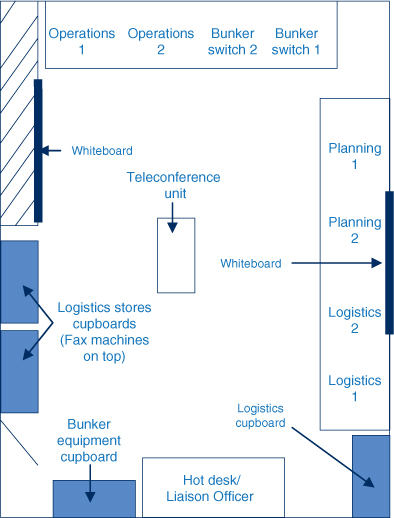
|
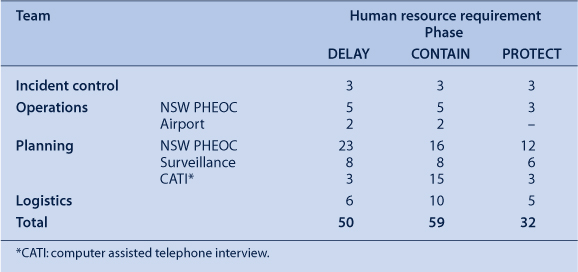
|
The logistics team was responsible for:
-
co-ordination of administrative support
-
employment and remuneration of staff
-
management of budgets and expenditure
-
internal computer networks and communication systems
-
management of the state and national medical stockpiles.
Two of the key communication tools within the public health network were the NSW Health public health emergency response wiki (containing a repository of response documents that the public health network could view and edit) and NetEpi (a national web-based public health data collection system) for the NSW Department of Health, area health service, and PHU staff.21 The logistics team managed access to these systems for the network and created generic email accounts and direct phone lines for each team within the NSW PHEOC to facilitate and coordinate information flow.
At the peak of the CONTAIN phase, around 1200 people were in quarantine or isolation in NSW.22 Quarantine packs were provided to assist with home isolation or quarantine. St John Ambulance (NSW) was tasked with the assembly and delivery of these packs to PHUs for further distribution. The packs included:
-
information sheets
-
surgical masks
-
antibacterial hand wash
-
tissues.
For some people, home quarantine or isolation created a range of accommodation and general welfare issues. In the Sydney metropolitan area, the NSW PHEOC logistics team was responsible for co-ordinating the response to these issues for cases and their contacts; in rural NSW, St John Ambulance was tasked with this responsibility. On 26 May, the State Emergency Operations Centre began co-ordinating the response to welfare issues, as for a major state incident. The type of welfare assistance required included:
-
requests for food
-
medical assistance or supplies
-
financial assistance
-
accommodation.
PROTECT phase
Australia (and NSW) moved to the PROTECT phase of the public health response on 17 June in recognition of the generally mild clinical characteristics of the virus, and widespread community transmission in Victoria.23
Planning
During the PROTECT phase, the planning effort shifted to communicating with at-risk groups and health service providers, in order to identify and treat those considered at-risk of serious influenza-related illness. Targeted communications to general practitioners and Aboriginal Medical Services were essential to promote distribution of anti-influenza medication from the national medical stockpile to those with influenza-like illness in at-risk groups, and for those with moderate or severe illness.
Planning also focused on the distribution of oseltamivir suspension to designated community pharmacies and regional and rural health services to ensure that adequate supply was available for the treatment of eligible children aged under 5 years. The planning team also spent considerable time providing updates on the progress of the epidemic across NSW to health service groups, and providing input into clinical policies, especially those for at-risk groups such as pregnant women.
By August, the focus of the planning team had shifted towards the planning and roll-out of the pandemic influenza vaccine program (which commenced on 1 October). Priority groups for vaccination included health-care workers and those at risk of severe influenza-related illness.24
Operations
Following a shift in testing recommendations, the operations response during the PROTECT phase was largely centred on the surveillance of hospitalised cases associated with pandemic (H1N1) 2009 influenza. During this phase PHUs were responsible for follow-up (to gather detailed risk factor information) and investigation of all confirmed cases who were hospitalised. The aim was to better understand the characteristics of people hospitalised with pandemic (H1N1) 2009 influenza in order to identify the groups of people at highest risk of severe disease.
From the date of the first identified case to 30 September 2009, 5174 laboratory-confirmed cases of pandemic (H1N1) 2009 influenza were reported in NSW. Of those confirmed cases, 1270 people were admitted to hospital and 234 of these cases required admission to intensive care units (Table 3). To 30 September, 51 deaths associated with confirmed pandemic (H1N1) 2009 influenza were reported in NSW.25
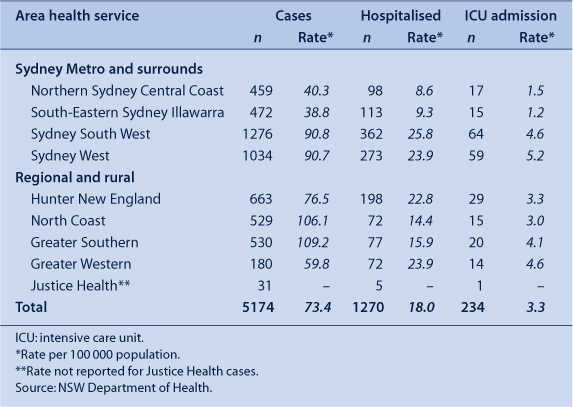
|
Logistics
During the PROTECT phase, the logistics team was largely involved in accessing and delivering anti-influenza medication and personal protective equipment from the state and national medical stockpiles (Table 4).

|
Efficient distribution systems for oseltamivir suspension were a considerable challenge for the logistics team as stock levels did not allow issue to all general practitioners (GPs). On 25 June, the Pharmacy Guild of NSW selected 35 community pharmacies within the Sydney metropolitan area to supply oseltamivir suspension. In rural NSW, area health services were issued with stock of oseltamivir suspension to distribute as needed within the community.
Lessons learned
Co-operation throughout the NSW Health network during a real emergency was central to the effective public health response. It became apparent that considerable resources were required to sustain a public health emergency response over several months. Some of the challenges for future planning and key lessons learned from the response include:
-
the value of investment in public health emergency planning strategies and exercises
-
the need to identify appropriate surge capacity for the public health workforce
-
the importance of clear guidelines for workers involved in the response
-
the importance of timely communication
-
-
to the community
-
throughout the public health network
-
to health-care providers.
-
-
access to timely and high quality surveillance data
-
the value of flexible information management systems
-
the importance of logistical planning and support
-
the need for laboratory surge capacity including timely electronic reporting.
Conclusion
This pandemic resulted in the largest NSW public health response within the last half century. The intensive public health response initiated in NSW during the early phases of the pandemic was able to delay the spread of infection. However, the nature of influenza meant that the disease eventually spread through the community. Fortunately, pandemic (H1N1) 2009 influenza caused relatively mild symptoms in most people. However, some people experienced severe illness and the impact on the NSW public health network and hospital services was substantial. High level co-ordination from public health teams and effective communication strategies were critical to the successful management of the public health response in NSW.
Acknowledgments
We acknowledge the work of the NSW Public Health Emergency Operations Centre staff and the public health network who contributed long hours and performed painstaking work to support the public health response to pandemic (H1N1) 2009 influenza. We also thank the staff of the NSW Department of Health, area health services and public health laboratories who contributed to the surveillance systems, influenza testing and data collection.
[1]
[2]
[3]
[4]
[5]
[6]
[7]
[8]
[9]
[10]
[11]
[12] Jorm LR, Thackway SV, Churches TR, Hills MW. Watching the Games: public health surveillance for the Sydney 2000 Olympic Games. J Epidemiol Community Health 2003; 57(2): 102–8.
| Crossref | GoogleScholarGoogle Scholar | PubMed | CAS | (Cited 9 October 2009.)
[16] Cretikos MA, Merritt TD, Main K, Eastwood K, Winn L, Moran L, et al. Mitigating the health impacts of a natural disaster – the June 2007 long-weekend storm in the Hunter region of New South Wales. Med J Aust 2007; 187(11–12): 670–3.
| PubMed | (Cited 9 October 2009.)
[19] NSW Public Health Network. Progression and impact of the first winter wave of the 2009 pandemic H1N1 influenza in New South Wales, Australia. Euro Surveill 2009; 14(42): ii–19365.
(Cited 29 September 2009.)
[22]
[23]
[24]
[25]

